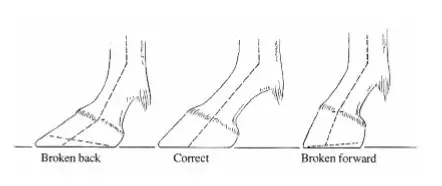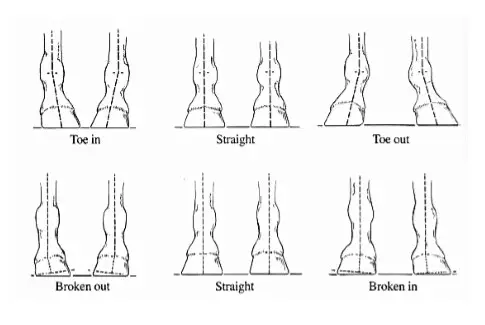Equi-note 27 Horseshoeing-the scandal exposed at competitions


Source: Equinamity.co
Horseshoeing-the scandal exposed at competitions
It is difficult to assess the state of horseshoing amongst geographically dispersed stables which contain widely different types and standards of riding.
However, at competitions the standard of shoeing becomes much easier to assess. This post shows evidence of poor horseshoeing quality at international competitions. As can be seen in the above photos. The hooves shown in this section are from leading international competitors principally in Grand Prix Dressage, 3-Day Event and Show Jumping.
Extensive research was conducted on 84 top-level international competition horses. As indicated in the previous post, four main problems were identified, which are:
-the extensive use of side clips on their front hooves
-incorrect hoof angles, both lateral and anteroposterior
-distorted hoof capsule contours
-ineffective/risky shoe shapes
Further comments on each of these problems follow.
Comments on main shoeing problems
1. Side clips
Side clips occur when the side of the shoe is raised. Its purpose is to stabilize the shoe. There are many pro’s and con’s on this subject which will be analyzed in later blog posts.
The following images indicate the three options for clips on the front hooves. The first photo on the left is with no clips, the middle photo has a single toe clip in the middle of the hoof and the photo on the right has two side clips, one on each quarter of the hoof.
Clip comparison
No clip One toe clip Two side clips

Occasional usage is made of two clips on the same side of the shoe for medical reasons, such as a split hoof wall, but this is rare. A key part of the problem of side clips is that the hoof wall is thinner along the sied of the hoof than at the toe. This increases the liklihood of soreness/lameness induced by the clip’s placement in this section of the hoof as well as the cut-out effect casued by the amount of hoof removed to seat the clip.
Why is this important? It is because the research showed that usage of side clips is extensive, as well as being linked to lameness, as the following table indicates.
Two side clips on the front hooves are linked to lameness
Type of clip Number of horses
Total analyzed 84
Total w/ side clips* 65
3-Day Event Dressage 29
Grand Prix Dressage 36
*Note: Total number of horses analysed=84; 19 horse difference vs total is that either they had no side clips or evidence was insufficient.
Clip-related unsoundness was present in an alarming 3/4 (65/84) of competitors.
The lameness observed is intermittent, which is described as a Grade 2 or 3 according to the AAEP scale. This is an entirely different type and level from the highly obvious Grade 5 level lameness which is immediately noticeable. Nevertheless, at this level of competition, it should still be regarded as serious.
How are side clips made?
It is important to note that raising the clips is an art in itself. Significant variations exist in terms of the clip’s overall size, location along the shoe’s branch, width, thickness (at base and amount of taper), height, sharpness of the point, angle to the hoof wall, fitting into the hoof, etc.
Another vital point is the hammering done by the farrier on the clip to angle it with the hoof wall. This is often performed in a rough manner and creates bruising.These are all highly significant issues which can determine whether the horse is comfortable with the shoe and clips. If it is not, lameness will be the result. This matter will be analysed in the next post.
2. Incorrect hoof angles
The hoof capsule has an overall cylindrical shape and grows continuously. It is therefore subject to an infinitely large number of changes to its length. This growth can be and usually is irregular along the perimeter of the hoof. By its very nature, all growth will create angle changes. For the sake of simplicity, these angles are divided into two main groups: the anteroposterior (front-back) and the mediolateral (inside-outside).
Anteroposterior angles
The anteroposterior angle must provide a pastern-hoof angle that is “straight”, when viewed from the side. If the shoeing is incorrect at either the toe or the heel, this will not happen. There are two main variations which occur, which show the hoof to be either “broken-forward” or “broken-back” as shown next.

Source: Butler Professional Horseshoeing
The dotted lines at the bottom of the hooves, indicate how much trimming is needed to correct the angle.
Mediolateral angles
The second main type of angle refers to the sides of the hoof, or the mediolateral. Medial refers to the side of the hoof closer to the horse’s mid-line and the lateral to the outside.
The starting point is based on the horse’s original skeletal structure, whereby the hoof and leg are constructed at a 90°-degree angle to the ground. If the angle is not 90° then it means that one side of the hoof is longer or shorter than the other. Bone and skeletal deformities are excluded from this analysis.

Source: Butler Professional Horseshoeing
This unevenness can happen from either unequal natural hoof growth and conformation (shown in the top row in the above image) or from a deficiency in the farrier’s trimming. When either of these two situations arise, the result is a crooked hoof. This is defined as either “broken-in” or “broken-out” as shown in the second row above.
Almost half of these top-level competitors exhibited an angle problem. Both front hooves and hind hooves were affected.
3. Distorted hoof capsule contours
The third shoeing problem dealt with the hoof capsule and its contour.
Overall, its shape must look like an extension of the leg and be part of an overall, harmonious conformation of the horse. It must look healthy, well-formed and balanced, and allow the horse to move comfortably and soundly.
Given the growth of the hoof, distortions to the capsule are continuous and can be rapid. Consequently, continual adjustments need to be made to each individual hoof at every shoeing.
A series of factors intervene to complicate this process, including genetics, conformation, health, injury, nutrition, stabling, environment (especially weather and temperature), workload, type of work, work surface, shoeing frequency, type and material of shoe, nailing, fitting of shoe, etc.
The following examples show a range of reasons why growth can be distorted.
Examples of distortion of hoof capsule
natural growth over-trim wrong trim neglect

Source left photo: Mike Ware-Director of the Australian College of Equine Podiotherapy
Source third photo: Tom Smith Farriers comments:” that he received the horse in this condition for purposes of re-shoeing”.
The quality of the farrier’s judgement is demonstrated as to which of the above listed elements they choose to prioritise to get the combination that is right for the horse.
4. Ineffective/risky shoe shapes
Shoes must be comfortable and functional to allow the horse to fulfil the tasks that have been set for it. Bizarre shoes which impede this are simply gimmicks. One of the most common faults noted in the research is a wide flat, smooth shoe which increases the risk of slipping.
In addition, there are also shoes which may be appropriate for the horse and its work, but which have been made badly by the farrier /blacksmith. These can damage the horse’s leg action.
Some examples follow.
Ineffective/risky shoe shapes

Issues which arise from each of these four problem areas will be analysed in greater depth in following posts.